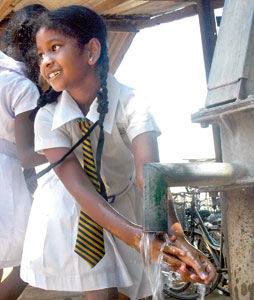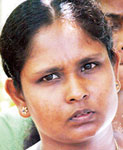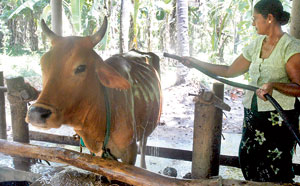Three days of each month, she “abandons” her two children to the care of her mother and trudges from house to house, 202 in all, carrying a sheaf of bills.
Smilingly shaking her head in a vigorous “No” to the query whether she has been bitten by a dog during her rounds, this water-meter reader in the Thalpotha area, in Polonnaruwa, says that she knows the householders so well that sometimes they even offer her a steaming cup of tea.
Although she gets paid a mere allowance of Rs. 2,000 for her meter-reading job, H.A. Deepika Lakmali considers it her duty because she and her neighbours have received a boon – clean water where earlier there was only brackish and dirty water from tube wells.
 |
| 2,000 students and 87 staff of Vincent Girls’ High School at Batticaloa await benefits from the urban component of the water scheme. Pix by Saman Kariyawasam |
There is also an underlying sorrow which makes her determined to sustain this rural water supply scheme at Thalpotha, for she feels her husband died for it. Quietly, she moves away from the knot of men and women who have gathered at the Randiya Praja Mula Sangwidhana premises close to two huge wells covered in blue to discuss the water scheme and steps into the brightly-painted office. With trembling lips and unshed tears glistening at the corner of her eyes, Lakmali points to a large photo of her husband hung on the wall next to that of the village committee running the water scheme.
“They were all hurrying to finish the work the evening before the launch of the water scheme when he had touched an exposed wire by mistake,” she says, adding, “current eka vedila maruna.” (He had been electrocuted).
He worked very hard for the project, says this 32-year-old widow, sad but happy that now his aspirations have been fulfilled.
Clean water was a yearning not only for the 202 families of Thalpotha but still is for hundreds, nay thousands of people in Sri Lanka, who have had to contend with dirty water, unfit for human consumption.
Many had been the hours they spent walking to other people’s compounds to carry back pots, buckets or buli full of water for their daily needs…….drinking, cooking washing and bathing.
Some were sceptical that it would work but after 202 got the connections in May 2008, the clamour has begun.
“Bothal mase there is a lethargy in paying the bills but they come round because water is essential,” says Lakmali.
For many of us in Colombo or other major towns, where the turn of a tap gives water, it is sometimes difficult to understand the plight of these humble men, women and children not only in remote but also so-called urban areas for this precious commodity.
Having travelled far and wide and seeing the hardship people across the board from all communities, Sinhala, Tamil, Muslim and Burgher, undergo it was the Asian Development Bank’s Project Specialist M. Thiruchelvam who sat down with the top officials of the National Water Supply and Drainage Board to work out the nitty-gritty of the Secondary Towns and Rural Community Based Water Supply and Sanitation Project spread across the country at Polonnaruwa, Batticaloa, Hambantota, Trincomalee (Mutur) and Anuradhapura.
The project estimated to cost over US$260 million (the government input being US$120m, the ADB’s US$138m and the beneficiaries US$3.2m) has been tailor-made to suit the needs of the different groups of people, be it rural or urban, taking into account the “water sources” available in each area. Although the main goal of the project is water and sanitation, other bonuses are waste-water systems, environmental programmes and self-employment through empowerment for many women.
 |
 |
| Kaththankudy: A woman clutching a file waits to hand over an application for a water connection |
Deepika Lakmali from Thalpotha |
After mobilization of the community, the only condition for the water schemes is the contribution of 20% of the cost either as cash, material or labour by the beneficiaries. Run by the community, the water supply scheme at Thalpotha is handled by a village committee which is responsible for its maintenance and repair through the monies collected on the water bills.
While Thalpotha’s supply scheme starts with two huge wells on state land from where water is pumped to a tower, stored and then sent to the 202 families through a network of pipelines over 7 km, in another area of Polonnaruwa, Chandana Pokuna in Hingurakgoda, it is a different source of water that had been tapped. Here 50 families have got wells, 99 water-seal latrines and seven rain-water harvesting tanks. The wells have been built newly, where there were none or old wells have been repaired while the villagers’ pit latrines have been replaced by water-seal toilets.
Wathura gena prashna thibba, says Sujatha Srimathi, a mother of three, explaining that water was a problem. With her neighbours echoing her thoughts she recalls the hours spent on collecting water. It was to the ela (irrigation canal) that she would take her daughters for a bath but when the water was restricted depending on what stage the paddy cultivations were, she and her children would have to go to the wewa, taking with them their heap of dirty clothes.
Now an active member of the Randiriya women’s group, she points out that many are the members who have benefited from the other aspects of the water project. Self-employment projects are thriving because no longer do they have to spend time collecting water and the fillip has been loans (micro-finance) given by Randiriya.
Brick or pot making; batik work; buying paddy, boiling, husking, pounding and selling the rice are a few of the self-employment opportunities that the women have embraced along with unusual jobs such as running a “beheth sappuwa”.
“You just missed the milk lorry,” says Gnanawathie Menike, whose day has started early morning with the first duty of giving a long bath to her beloved ‘Kalu’, ‘Raththi’ and others after which she milks them.
Gnanawathie is the owner of four milch cows and two calves and her housework and cooking are on the back-burner until then. Miffed at not being let loose in the garden for grazing, Kalu with the wide eyes grumbles gently to Gnanawathie while she in turn pats her and promises to do so soon, calling out to ‘Chooty’ to be patient for her attention.
When they drew water for the first time from their brand new wells their happiness brimmed over, says Sujatha who still shudders at the thought of seeing the body of a person who had fallen into a decrepit unprotected well.
Their gardens have also been enriched by the plants distributed under the project and S.M. Chandralatha , 58, shows the height of the mango and delum (pomegranate) trees she has. Watering them tenderly with water from the rain-water harvesting tank she secured under the project she adds: Thama mal pipune ne. (They have not flowered yet.)
Meanwhile, 90 km away in hot and withering weather diverse groups of people await the end of June and with it clean water from their pipes.
Two wells and a few broken pipes giving a supply on and off are the only sources of water the 2,000 students and 87 staff of Vincent Girls’ High School at Batticaloa have.
 |
| Gnanawathie from Chandana Pokuna, in Hingurakgoda: Proud owner
of four milch cows |
Keeping the toilets clean is an obvious problem, according to Principal S. Kulendra Kumar and the children suffer, particularly the hostellers.
As the stench from the toilets wafts across the school with the dry harsh wind, danger lurks right next to a set of classrooms in the form of an unprotected but deep well from which the children are compelled to draw water.
It is also the scarcity of water that keeps the upper floor of the nurses’ hostel of the 900-bed Batticaloa Teaching Hospital vacant, Director Dr. K. Murugananthan points out, explaining that the pipe-borne supply is available only once in the morning and once in the evening.
With water being needed by as many as 3,500 at the hospital and crucial for the operating theatre and the sterilization room, he points out that the “hospital is the biggest consumer of water in Batticaloa”.
In the township of Batticaloa which is on a tortoise-like isle, the main problem with water is its salinity and quantity, explains Mr. Thiruchelvam of the ADB. As they await the augmented water supply scheme under the urban component of the ADB project, not only the hospital but also the prison benefits from the waste-water treatment plant already set up there. This plant which was commissioned in January this year is a first for the whole of the Batticaloa district, the Sunday Times understands.
Away from Batticaloa town at Kattankudy said to have the highest population per sq.km in Asia, men and women clutching files crowd the water office to hand over applications for a water connection, with some saying that now they have to get their requirements from the single tap in the mosque premises and others pointing out that they collect their stocks from a tube well.
With a baby in her home, Fathima Imsana, 23, is fearful. Knowing the dangers of “dirty water with a bad smell”, she says she is worried that her baby will fall ill. The colour is bad and that’s why she wants to register for the water supply.
All of them are asking only for something we take for granted – water which is the most basic of basic necessities.
On the road to providing pipe-borne drinking water
With the goal of the National Water Supply and Drainage Board (NWSDB) being the provision of pipe-borne drinking water to 45% of the population by 2015, it operates 291 water supply schemes which cover 30% while tube-wells serve another 8%, it is learnt.The ADB being a “continuous partner” in the water supply and sanitation sector for over 20 years, it provided technical assistance in 2001-02 to draw up the Secondary Towns and Rural Community Based Water Supply and Sanitation Project, in support of the poverty reduction partnership agreement with the government.
As of May the project’s urban water supply schemes are in their final phase while about 95% of the work in the rural water supply schemes has been completed.
The project hopes not only to reduce the incidence of water-borne diseases but also the cash and time that people spend to collect water for their basic needs, according to Mr. Thiruchelvam, and will also increase the capacity of water sector institutions to operate, maintain and augment existing water sche-mes and invest in new water schemes in rural and urban areas.
Under the project nearly a million people are expected to get safe water with about 171,500 being provided sanitation in the rural areas of Anuradhapura and Polonnaruwa districts and in the towns of Batticaloa, Hambantota, Mutur and Polonnaruwa.
Focusing on Polonnaruwa, the Deputy Project Director M.T.M. Razil said that the urban component is to be completed in September and will facilitate water from the Manampitiya intake of the Parakarama Samudraya being channelled to a state-of-the-art treatment plant, then onto three towers at Gallella, Bendiwewa and Sewagama and thereafter distributed to 85,000 families.
The rural component envisages the provision of water through piped schemes, dug wells, tube wells and rainwater harvesting tanks to 131,300 families and toilets to 48,400 families.
Under the rural water supply schemes in Batticaloa, according to NWSDB’s Additional General Manager T. Thirunawakarsu wells, tube wells and rainwater harvesting tanks will benefit 8,293 families.
The urban water supply and sanitation schemes will facilitate the intake of water from the Unnichchai tank, transmission to the treatment plant, on to the storage towers and distribution to 50,000 connections throughout the day and night at Manmunai Pattu, Kattankudy, Manmunai North, Eravur and Eravur Pattu. Currently, there are only 1,400 pipe-borne connections providing one-hour of water in the morning and another hour in the evening.
The project is also seeing drainage systems in Manmunai Pattu and Kattankudy being improved, the Batticaloa Hospital and prison gaining a waste water plant, the augmentation of the Unnichchai tank and a host of other benefits.
|





